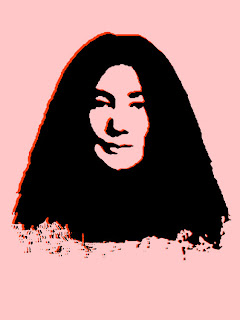 The Naked Kiss dir. Samuel Fuller
The Naked Kiss dir. Samuel FullerLeave it to punch-drunk Fuller to film my favorite opening sequence in forever. Godard deemed it "cinema-fist" and your eyes immediately open to the sight of a call girl wailing on her audience and her john, sending the camera reeling. She kicks the ass-whup up a notch when he yanks off her wig then puts on her face over the opening credits. It's pretty much down hill from there, at least until the doe-eyed crippled children's choir comes in to cut their latest hit. Tearjerker seems too placid an action to apply to Fuller; it's instead kin to taking a pair of needlenose pliers to the tear ducts.
La Jetee/ Sans Soleil dir. Chris MarkerI liked that when I screened 1983's
Sans Soleil for some friends, half of them fell asleep within the first half-hour, their slumbering forms mirroring those of the commuters captured early on in the film. Perhaps being asleep is the best way to process the dreamlike logic that Marker follows, or, as his narrator puts it: "Not understanding adds to the pleasure." Between this and the recent picture book of his photography, 2007 has given us the most tenable grasp of the man in a good number of decades. How it makes me long to see his 48
other films of his that are impossible to track down save as bootlegs (
Le Joli mai is on the way to me as I type). Already, he wanes just like his beloved Cheshire Cat.
 The Lady Vanishes dir. Alfred Hitchcock
The Lady Vanishes dir. Alfred HitchcockMarker's mid-movie meditation on Alfred Hitchcock's
Vertigo and that Sisyphean search for perfect memory led me back to the man. I've been grappling the past couple days about why I loved Hitchcock so much as a child. At first I thought it had something to do with the
Alfred Hitchcock Presents Nick at Nite reruns that I saw as a child, that iconic silhouette and weird lumbering music intro to his show, his droll, black liquorice humor. That didn't seem quite right though, and then I remembered that I had a complete set of
Alfred Hitchcock and the Three Investigators juvenile detective novel series. Could he have been responsible for both reading and movie-watching? And is there any director working today to have that sort of ubiquity to where he is a fictional brand-name, much less a recognizable portrait? Scorsese's Dead End Kids? Wes Anderson's Effete Wilting Flowers?
Despite that childhood fascination with Hitchcock, I have barely built on it as an adult. And I had definitely never seen any of Hitchcock's UK work. With its toy-like opening,
The Lady Vanishes evoked the miniatures of childhood, but it still almost lost my roommate and me in the first half-hour, displaying his peculiar brand of humor that makes the movie seem like the grandmother to 1955's
The Trouble with Harry. By the last third though, it swerves into some crackling espionage.
Lola dir. Rainer Werner Fassbinder Will I be able to stand the nine hours plus change of the forthcoming DVD set of
Berlin Alexanderplatz? As I seem to be drawn to women who work far too much, surely I can get with a man who his friends deem died of overwork, releasing some sixty films in thirty years.
While a staple of my Existential college courses, I hadn't revisited Fassbinder since then. I have
Despair (still unavailable on DVD) and am curious to revisit that, but watched
Lola first, a part of Fassbinder's BRD Trilogy. His theatre roots and obsessing over Douglas Sirk comes through in his gels, the characters wading through rooms and courtyards drenched in amber and plum, character faces awash in clammy blues and flustered, almost feverish pinks. What startles me in the commentary (yet explains how he worked so fast) is that Fassbinder insisted on first takes and also emphasised not explaining character motivations to his actors. He believed that just as we move through this farce of a life not quite sure what we're doing or why, so should his actors.

 About the only thing I can be grateful for is that they didn't concoct a Yoko Ono character that lets out a scream and ruins "the dream" for everybody else. To this day, there's no finer way to pick a fight in mixed company (short of admitting that you can't stand Neutral Milk Hotel) than to state that you love Yoko Ono's music or consider what she did 'music' (speaking of, there's an illuminating and slightly daft interview with Ms. Ono in the now-revitalized Arthur Magazine). And yet, for those who take the Beatles myth as gospel, Yoko is crucial. Cast her as Kali or Mary Magdalene or the Wicked Witch, but she is the underlying reality to that Fab Four religion and the vitriol against her remains undiminished. Just read the comments that accompany her devastating "Cut Piece," which anticipates such anonymous (and festering) hatred within the very piece.
About the only thing I can be grateful for is that they didn't concoct a Yoko Ono character that lets out a scream and ruins "the dream" for everybody else. To this day, there's no finer way to pick a fight in mixed company (short of admitting that you can't stand Neutral Milk Hotel) than to state that you love Yoko Ono's music or consider what she did 'music' (speaking of, there's an illuminating and slightly daft interview with Ms. Ono in the now-revitalized Arthur Magazine). And yet, for those who take the Beatles myth as gospel, Yoko is crucial. Cast her as Kali or Mary Magdalene or the Wicked Witch, but she is the underlying reality to that Fab Four religion and the vitriol against her remains undiminished. Just read the comments that accompany her devastating "Cut Piece," which anticipates such anonymous (and festering) hatred within the very piece.




